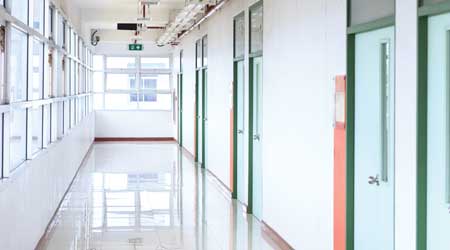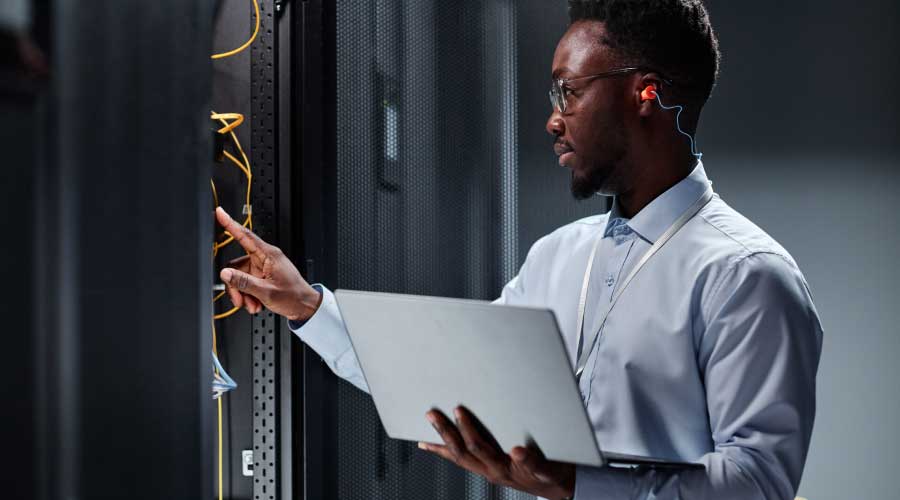School Security: Make the Right Doors Choices
Doors, locks, and other door hardware must be chosen carefully. Here is some advice to select products for everyday security, as well as lockdown situations.
Doors play a critical role in any facility. They keep occupants safe from the elements and unwanted outsiders, while allowing them to exit quickly and safely when necessary and preventing fires and smoke from spreading. But it’s just in the last decade or two that they’ve attracted much attention.
“Fifteen years ago, no one was overly concerned about doors and hardware,” says Jerry Heppes, Sr., chief executive officer with DHI, an association for door security and safety professionals, as well as with the Door Security and Safety Foundation, its educational and advocacy arm. As long as they worked, most doors received little attention. Maintenance wasn’t always a priority.
That’s changed. More facility managers and building owners, as well as the occupants who work, teach and learn, provide care, and visit different buildings are paying attention to the types of doors installed.
Behind much of this focus is greater concern about active shooter events. While they remain extremely rare, they’re occurring more often. According to FBI statistics, an average of about five active shooter events occurred each year between 2000 and 2004. That number jumped to an average of 21.4 per year, for the years 2013 to 2017.
The key for many facility managers is to keep in mind the need to balance security and life safety, while also complying with relevant codes and standards. In the aftermath of a shooting, calls to strengthen security, even at the expense of life safety, can grow loud. Acquiescing in these demands could prove dangerous in an emergency.
To be sure, the right solution will vary between facility types. In a memory care unit, for instance, solutions that keep occupants from inadvertently wandering off typically will be higher priority than they would be in an office building. Just as important is the proper maintenance, operation, and upkeep of the solutions installed.
Security in schools
Security has become an increasing focus within most educational facilities. This is understandable given the high-profile active school shootings that have occurred over the past 20 years. Whenever one occurs, “there’s a feeling of, I’ve got to do something,” Heppes says. However, a rush to action can lead to proposed solutions that themselves would create hazards and violate life safety codes.
For instance, barricades often are touted as way to keep an active shooter from entering a room. “They may also trap occupants inside in an emergency, such as a fire,” says John Clancy, principal with Architectural Openings Consultants.
Moreover, the risk of fire is real. Each year from 2013 to 2017, more than 4,600 fires occurred at educational facilities, statistics from the National Fire Protection Association (NFPA) show. They caused an average of $8.4 million is property loss and nine injuries although fortunately no fatalities during this period.
Similarly, barricades can prevent those who need to enter a room to provide help from doing so within a reasonable amount of time. Consider a situation in which one or two students barricade another student in a room, with a goal of assaulting him or her. To stop the assault, administrators need quick access. Most barricades will prevent that, potentially putting the student in greater danger.
The proper lock, properly installed, and in compliance with life safety codes, can provide protection from criminals outside a room or building, while allowing those who need to leave to do so safely. To date, no active shooter has violated a lock, Heppes says. The closest they’ve come is breaking the glass in the door in which the lock is encased to try to reach around and undo the lock. This risk can be addressed by eliminating or changing the glass, he adds.
Locks should allow the proper authorities to enter a room when necessary, Heppes says, adding that the codes exist to ensure access. Consider a similar situation as above, except that instead of barricading the room, the students lock it. Then, one of the students has a seizure and needs immediate medical attention. In the moment, the students may panic and be unable to undo the lock from inside. But an authorized person with a key can unlock the door.
The Door Security and Safety Foundation provides three guidelines that should apply to school lockdown solutions. Any solution should:
- Open from inside the room without requiring tight grasping, pinching, or twisting of the wrist, and be accomplished in one operation. The goal is to allow occupants to open the door in a single motion, Heppes says. This may be critical in emergencies, when students and staff may be panicked and not thinking clearly. “You want to eliminate human error,” he adds. The single motion also makes it easier for most occupants with disabilities to unlock the door.
- Lock and unlock from inside a classroom without requiring the door to be opened, while still allowing staff to enter in an emergency.
- Lock automatically or have a simple locking mechanism requiring a pushbutton, key, card, fob, or fingerprint that will lock the door from inside the classroom without having to open the door.
Most facilities must work within budgets, including for security measures. The good news is that installing safe, secure doors and hardware typically doesn’t have to break the bank. Quality door systems are available at a range of prices, Heppes says.
Related Topics:















